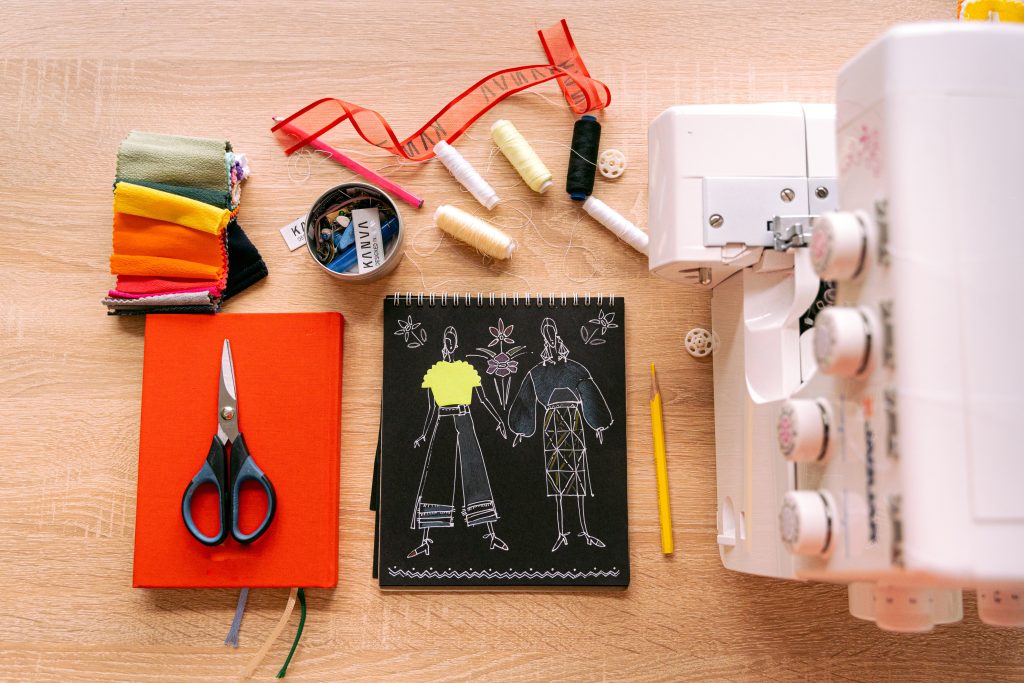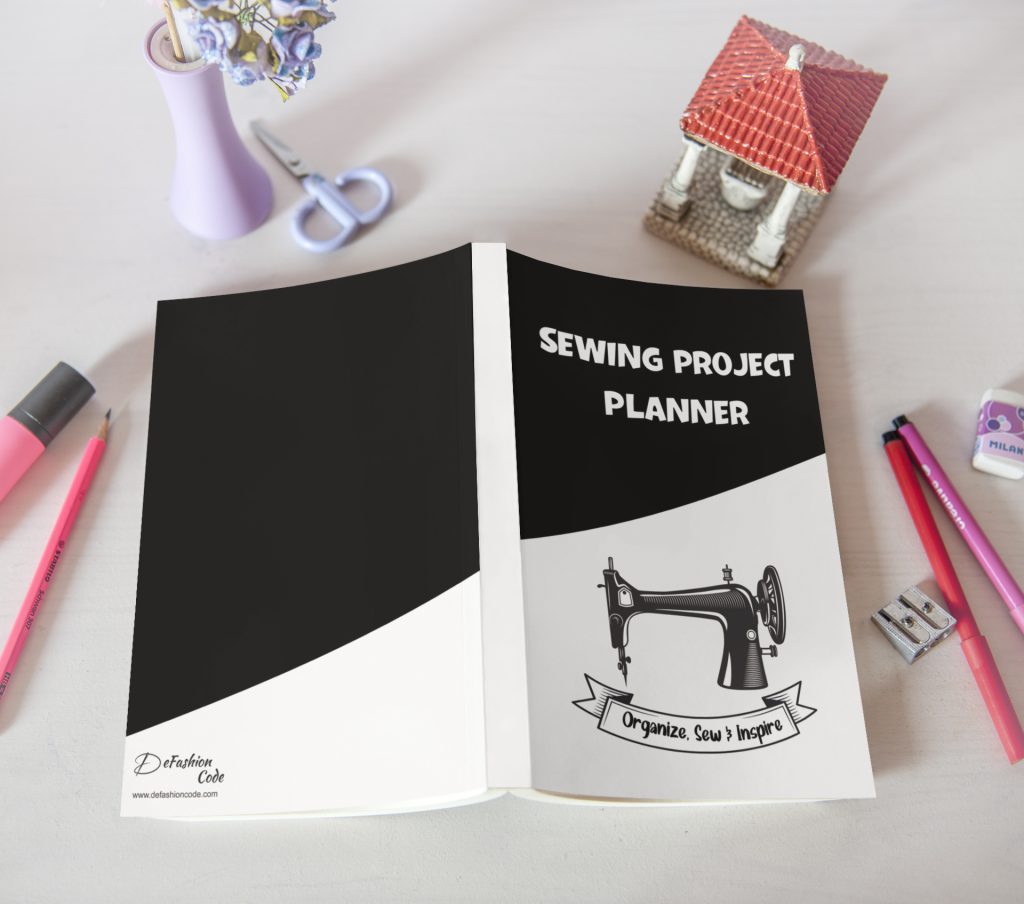Welcome, sewing enthusiasts! Are you tired of feeling overwhelmed with your sewing projects?
Say goodbye to chaos and hello to organization with the help of a sewing log book!
In this blog post, we’ll explore the wonders of using a log book to categorize projects, record measurements, document sketches and more. Get ready to revolutionize your sewing experience and unleash your creativity with the power of a sewing log book. Let’s dive in!
Why Should You Use a Log Book to Categorize Sewing Projects?

- Clarity and Organization:
Categorizing your projects provides a clear overview of all your sewing endeavors, ensuring you can easily navigate and locate specific projects whenever needed. No more wasting time searching through piles of materials or notes.
- Efficient Time Management:
By categorizing your projects, you can prioritize and plan your sewing time effectively. Identify high-priority projects, allocate resources accordingly, and streamline your workflow to optimize productivity. Say goodbye to wasted time and hello to a more efficient sewing schedule.
- Improved Focus and Progress Tracking:
Categorizing projects by type or skill level helps you maintain focus and track your progress as a sewist. It allows you to set achievable goals, celebrate milestones, and gauge your growth over time, providing valuable insights into your sewing skills and accomplishments.
Tips for Categorizing Projects:
Let’s embrace the joy of an organized sewing life and let your creativity flourish.
Here are some tips in categorizing projects:
1. By Project Type:
– Organize projects based on garments, accessories, home decor, etc.
– Focus on specific areas of interest.
2. By Skill Level:
– Group projects by complexity or skill level.
– Track your progress as a sewist.
3. Visual Clues:
– Use color-coding or labeling systems.
– Sticky tabs, washi tape, or colored dividers can be helpful.
The Importance of Recording Measurements

Recording measurements is vital in the world of sewing. Accurate and precise measurements are the foundation for creating well-fitting garments and ensuring successful sewing projects. By diligently recording measurements, you can track your progress, make adjustments as needed, and achieve the desired fit and overall outcome. It helps you maintain consistency, saves time and effort, and ultimately elevates your sewing skills. Whether you’re a beginner or an experienced sewist, recognizing the importance of recording measurements is key to achieving sewing perfection.
Tips for Recording Measurements:
1. Utilize a Dedicated Measurement Section:
– Designate a specific section in your log book for recording measurements.
– Create labeled columns or rows to easily input and reference measurements.
2. Include Additional Notes and Observations:
– Leave space for additional notes or observations regarding measurements.
– Record any relevant details such as body posture, fitting adjustments, or changes in body size.
By implementing these tips, you can effectively record measurements in your log book, maintaining organization and creating a reliable reference for your sewing projects. This approach helps you track progress, make accurate adjustments, and achieve desired fit and outcomes with ease.
Documenting Sketches

Sketching allows us to visualize our ideas, plan designs, and bring our sewing projects to life. Let’s discover how incorporating sketches into our sewing log book can enhance our creativity and organization.
Why Document Sketches?
– To Visualize Your Ideas:
Sketching helps you visualize and refine your design ideas before diving into the construction process.
– Plan and Customize:
Documenting sketches allows you to plan and customize your projects, ensuring they align with your vision.
Tips for Documenting Sketches:
1. Design Inspiration:
– Collect design inspiration from various sources, such as fashion magazines, Pinterest, or your own imagination.
– Include images or references in your log book to inspire your sketches.
2. Sketching Techniques:
– Develop your sketching skills by practicing different techniques, such as rough sketches, detailed illustrations, or technical drawings.
– Experiment with shading, fabric textures, and color swatches to bring your sketches to life.
Grab your pencils, markers, and log book, and let your creativity soar as you bring your sewing projects to life, one sketch at a time!
Jotting Down Client Contact Information

If you’re taking your sewing skills to the next level by offering custom garments or taking on client projects, it’s crucial to stay organized with client information. In this section, we’ll explore the importance of jotting down client details and how a sewing log book can help you keep track of important information for seamless communication and exceptional customer service.
Why Jot Down Client Contact Information?
By jotting down client contact information in your sewing log book, you’ll have everything you need at your fingertips to provide exceptional service and maintain clear communication. Keeping track of client preferences and contact details, may also provide a personalized and tailored experience.
Let’s keep our clients’ details organized, provide personalized experiences, and elevate our sewing business to new heights!
Tips for Jotting Down Client Contact Information:
1. Client Profile Page:
– Create a dedicated profile page for each client in your sewing log book.
– Include their name, contact number, email address, and physical address for easy reference.
2. Detailed Notes:
– Make detailed notes about each client, including their preferences, measurements, and any special instructions.
– Use your log book to jot down important information shared during conversations or consultations.
Next, we’ll dive into Billing Clients for your sewing projects. Stay tuned for valuable tips on managing your finances and ensuring the success of your sewing ventures.
Billing Clients

As you provide your sewing services, it’s essential to ensure a smooth and efficient billing process. By using a sewing log book, you can track payments, and maintain a clear financial record. Let’s dive into the world of billing and discover how your log book can be a valuable tool in managing your finances.
Why Efficient Billing Matters:
– Professionalism: A well-organized billing process enhances your professionalism and builds trust with your clients.
– Financial Stability: Timely and accurate invoicing ensures you receive timely payments, contributing to your financial stability and business growth.
Tips For Billing Clients:
1. Record Payment Details:
– Maintain a record of all payments received from clients.
– Log the date, and amount received in your log book.
2. Due Date Tracking:
– Keep track of invoice due dates and payment deadlines in your log book.
– Set reminders to follow up with clients for any overdue payments.
By leveraging your sewing log book for billing, you can streamline your invoicing process, maintain a clear financial record, and ensure timely payments from your clients. With accurate and efficient billing, you can focus more on the creative aspects of your sewing business and provide exceptional service to your clients.
Congratulations, sewing lovers!

We’ve explored the key elements that make a sewing log book indispensable for organizing and enhancing your sewing projects. But wait, there’s even more to discover! Defashion Code offers an exceptional collection of sewing log books that encompass all these important elements and beyond.
Our thoughtfully designed log books provide dedicated sections for each aspect we discussed today, ensuring a seamless and efficient organization process to revolutionize your sewing experience.
Elevate Your Sewing Projects with Our Log Books
Defashion Code’s sewing log books are carefully designed to empower and inspire every sewers. With our log books in hand, you’ll experience a whole new level of organization, creativity, and project management.
Defashion Code’s Log books include:
- Table of Contents
- Project Name
- Start Date, End Date
- Client Information (Name, Phone Number, Email, Address)
- Sewing Inspirational Quotes
- Project Description
- Measurements
- Materials
- Setup (Machine, Thread, Needle, etc.)
- Sketch
- Notes
- Billing (Project Cost)
- Project Difficulty Rating
Discover the magic of our log books by visiting defashioncode.com. Explore the wide range of options available and find the perfect log book to suit your needs. Whether you’re a beginner or a seasoned seamstress, our log books will become your trusted companion on your sewing journey.
Wishing you endless inspiration, seamless organization, and the fulfillment of all your sewing aspirations. Happy sewing, and may your log book help you in your sewing success!



